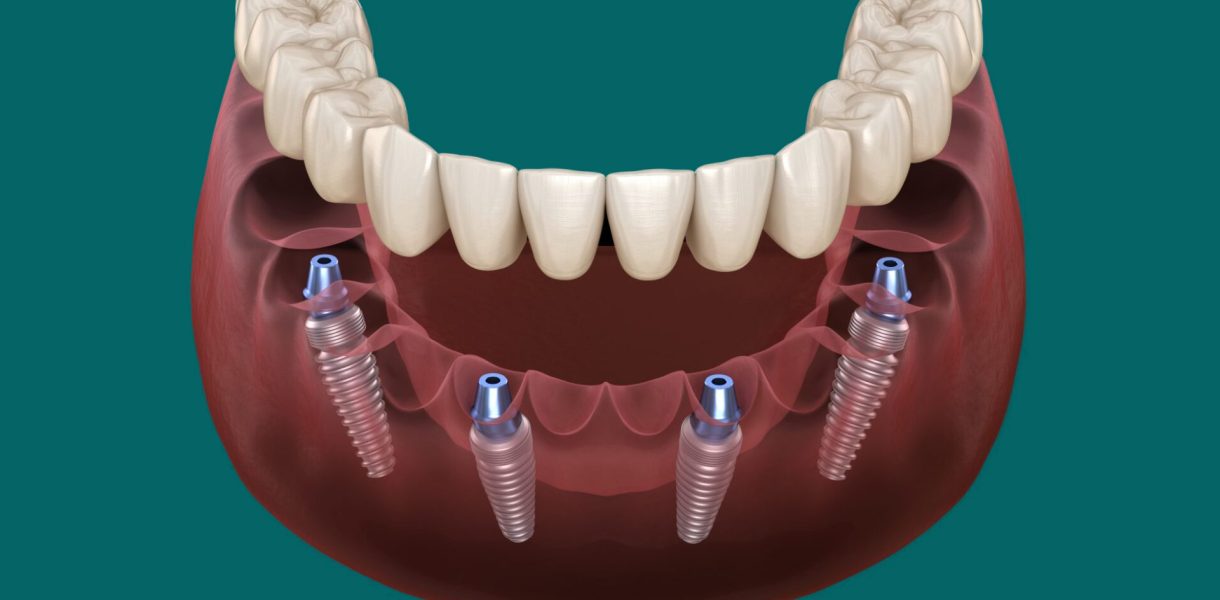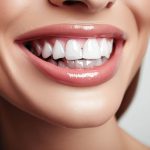The concept of “all-on-4” dental implants pertains to a methodology for embedding dental prosthetics within the oral cavity. In this procedure, the entirety of one’s dentition finds support from merely four implants securely anchored into the mandibular bone. The process revolves around the comprehensive substitution of all the maxillary or mandibular teeth with synthetic counterparts. Its ascendancy over the conventional dental implantation technique derives from the requirement of only four strategically positioned implants within the mandibular structure to sustain the full spectrum of dentition. This simplifies the procedure, rendering it notably more concise.
It is imperative to note that these four implants assume a titanium composition, chosen for its inherent capability to seamlessly amalgamate with the mandibular bone through a process known as osseointegration. It is pertinent to underscore that all-on-4 implants establish a status of permanence within the dental landscape, rendering them intrinsically irretrievable.
In a conventional all-on-4 dental implant configuration, four helical implants are accompanied by a horseshoe-shaped titanium framework sculpted to precisely conform to the anatomical arch of the mandible. The superior aspect of this frame features apertures meticulously tailored to accommodate the implants, a role formerly fulfilled by intrabony insertions. The inferior extremity of this framework serves as the point of attachment for the synthetic dental components. Typically, these dental facsimiles are manufactured from premium-grade dental ceramics or acrylic materials, and their affixation to the framework relies on mechanical assembly techniques, primarily involving screws or bolts. The twin objectives governing all-on-4 dental implants encompass both functional efficacy and aesthetic appeal.
The Merits and Demerits of Electing All-on-4 Implants
Advantages:
- Facilitation of a Natural Oral Experience: When a dental professional evaluates a patient’s candidacy for all-on-4 implants, the implants are custom-designed to emulate the semblance of genuine dentition. This extends to factors such as mastication functionality, tactile sensation within the oral cavity, and maintenance protocol. Furthermore, there exists the added virtue of possessing an immaculate set of lustrous, perfectly aligned teeth, thereby affording the recipient a radiant and resplendent smile.
- Expedited Surgical Intervention: The surgical aspect of all-on-4 dental implantation manifests as an expeditious endeavor, with an average duration spanning 3 to 4 hours. Notably, this timeframe may exhibit variances contingent upon case-specific complexities and the recipient’s oral health status. Nevertheless, the procedure in its entirety is consummated within a solitary day, culminating in the immediate acquisition of provisional prosthetic replacements. However, it merits mention that the provisional dental components must be subsequently extricated, with permanent substitutes affixed at a later juncture.
- Diminished Implant Quantity: The all-on-4 implant paradigm necessitates the placement of a mere quartet of strategically located implants within the mandibular structure, as connoted by its nomenclature. This confers a distinct advantage vis-à-vis alternative dental implant techniques, which often mandate a greater number of implantations. The paucity of implants not only translates into fiscal savings and procedural streamlining but also confers favor upon patients grappling with extant bone atrophy. The angular disposition of implants optimizes the utilization of extant osseous tissue, obviating the requisite for supplementary bone grafting procedures in numerous instances.
- Cost Efficiency: All-on-4 implants tend to be comparatively economical when juxtaposed against alternative comprehensive arch-replacement modalities. This economic viability emanates from the inherent paucity of implants deployed and the concomitant abbreviations in treatment duration.
- Elevated Success Rates: The success rate attendant to all-on-4 implants resides at a significantly elevated threshold, with figures approximating a 94-97% efficacy rate. Instances of implantation failure represent a distinct minority, affecting only approximately 5% of the patient cohort.
Disadvantages:
- Incompatibility with Growth Phases: All-on-4 dental implants, akin to their dental implant brethren, embody a permanent oral rehabilitation protocol. As such, individuals who are still undergoing physical maturation and exhibit the potential for mandibular expansion or morphological alteration may find all-on-4 implants unsuitable. The titanium framework utilized is custom-engineered to conform precisely to the mandibular contour. Any deviation from this prescribed configuration could engender the distortion of tooth alignment and facial aesthetics.
- Dietary Disruption: Post-surgical convalescence encompasses a two-week dietary regimen predicated exclusively on liquid nourishment. This hiatus in solid dietary intake is requisite to afford the surgical site adequate time for convalescence and facilitate the amalgamation of implants with the underlying bone. Subsequent to this initial fortnight, a transition to a soft dietary regimen ensues, predicated on the presumption that the mandibular tissues would have embarked upon the recuperative trajectory.
- Postoperative Discomfort: Following the surgical intervention, recipients may experience a modicum of tenderness and discomfort localized to the mandibular, oral, and pharyngeal regions. Although the expectation is that these sensations will ameliorate within a few days, it is imperative to adhere to the prescribed liquid dietary regimen during this healing phase. Simultaneously, maintaining optimal hydration and nutritional intake is imperative, as these elements are pivotal to the recuperative process.
- Implant Failure: On rare occasions, dental implants may encounter complications leading to their failure. This can be attributed to a lack of proper osseointegration or the manifestation of unforeseen complications. However, it is noteworthy that such events transpire infrequently, and the attending dental professional is typically equipped to proffer suitable remedial measures in the eventuality of implant-related issues.





